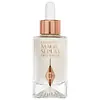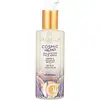What's inside
What's inside
 Key Ingredients
Key Ingredients

 Benefits
Benefits

 Concerns
Concerns

 Ingredients Side-by-side
Ingredients Side-by-side

Water
Skin ConditioningNiacinamide
SmoothingGlycereth-26
HumectantTriheptanoin
Skin ConditioningGlycerin
HumectantMethyl Gluceth-20
HumectantSilica
AbrasiveCamellia Oleifera Seed Oil
Skin ConditioningQuartz Powder
AbrasiveAmethyst Powder
AbrasiveRuby Powder
Skin ConditioningGold
Cosmetic ColorantButyrospermum Parkii Oil
EmollientPhenoxyethanol
PreservativeDimethyl Isosorbide
SolventPolysorbate 20
EmulsifyingGlyceryl Stearate
EmollientButylene Glycol
HumectantOctyldodecyl Oleate
EmollientBenzyl Alcohol
PerfumingMyrothamnus Flabellifolia Leaf Extract
EmollientPEG-100 Stearate
Octyldodecyl Stearoyl Stearate
EmollientSchisandra Chinensis Fruit Extract
Skin ConditioningCarbomer
Emulsion StabilisingSodium Gluconate
Skin ConditioningSodium Hyaluronate
HumectantChondrus Crispus Extract
Skin ConditioningSodium Hydroxide
BufferingSaussurea Involucrata Callus Extract
AntioxidantTocopheryl Acetate
AntioxidantAloe Barbadensis Leaf Juice
Skin ConditioningPolyglutamic Acid
Skin ConditioningPentylene Glycol
Skin ConditioningSorbitol
HumectantMagnesium Aspartate
Skin ConditioningZinc Gluconate
Skin ConditioningRosa Canina Fruit Extract
AstringentPolyhydroxystearic Acid
EmulsifyingOctyldodecanol
EmollientSodium Benzoate
MaskingPropanediol
SolventBiosaccharide Gum-4
Skin ConditioningXanthan Gum
EmulsifyingParfum
MaskingPlumeria Alba Flower Extract
Skin ConditioningPlumeria Rubra Flower Extract
Skin ConditioningLithothamnion Calcareum Extract
Skin ConditioningLactic Acid
BufferingPotassium Sorbate
PreservativeCaprylyl Glycol
EmollientCopper Gluconate
Skin ConditioningHydrated Silica
Abrasive1,2-Hexanediol
Skin ConditioningCitric Acid
BufferingSolanum Tuberosum Pulp Extract
SmoothingAcetyl Tetrapeptide-11
Skin ConditioningAcetyl Tetrapeptide-9
Skin ConditioningDehydroacetic Acid
PreservativeAscorbic Acid
AntioxidantGlutathione
Limonene
PerfumingGeraniol
PerfumingCitronellol
PerfumingLinalool
PerfumingCitral
PerfumingWater, Niacinamide, Glycereth-26, Triheptanoin, Glycerin, Methyl Gluceth-20, Silica, Camellia Oleifera Seed Oil, Quartz Powder, Amethyst Powder, Ruby Powder, Gold, Butyrospermum Parkii Oil, Phenoxyethanol, Dimethyl Isosorbide, Polysorbate 20, Glyceryl Stearate, Butylene Glycol, Octyldodecyl Oleate, Benzyl Alcohol, Myrothamnus Flabellifolia Leaf Extract, PEG-100 Stearate, Octyldodecyl Stearoyl Stearate, Schisandra Chinensis Fruit Extract, Carbomer, Sodium Gluconate, Sodium Hyaluronate, Chondrus Crispus Extract, Sodium Hydroxide, Saussurea Involucrata Callus Extract, Tocopheryl Acetate, Aloe Barbadensis Leaf Juice, Polyglutamic Acid, Pentylene Glycol, Sorbitol, Magnesium Aspartate, Zinc Gluconate, Rosa Canina Fruit Extract, Polyhydroxystearic Acid, Octyldodecanol, Sodium Benzoate, Propanediol, Biosaccharide Gum-4, Xanthan Gum, Parfum, Plumeria Alba Flower Extract, Plumeria Rubra Flower Extract, Lithothamnion Calcareum Extract, Lactic Acid, Potassium Sorbate, Caprylyl Glycol, Copper Gluconate, Hydrated Silica, 1,2-Hexanediol, Citric Acid, Solanum Tuberosum Pulp Extract, Acetyl Tetrapeptide-11, Acetyl Tetrapeptide-9, Dehydroacetic Acid, Ascorbic Acid, Glutathione, Limonene, Geraniol, Citronellol, Linalool, Citral
Water
Skin ConditioningDisodium Cocoamphodiacetate
CleansingCannabis Sativa Flower/Leaf/Stem Extract
AntioxidantSodium Astrocaryum Murumuruate
EmollientAspartic Acid
MaskingGlycine
BufferingArginine
MaskingAlanine
MaskingSerine
MaskingValine
MaskingProline
Skin ConditioningThreonine
Isoleucine
Skin ConditioningHistidine
HumectantPhenylalanine
MaskingSodium Gluconate
Skin ConditioningSodium Lactate
BufferingXanthan Gum
EmulsifyingSodium PCA
HumectantPhenoxyethanol
PreservativeEthylhexylglycerin
Skin ConditioningPolysorbate 20
EmulsifyingCitric Acid
BufferingParfum
MaskingWater, Disodium Cocoamphodiacetate, Cannabis Sativa Flower/Leaf/Stem Extract, Sodium Astrocaryum Murumuruate, Aspartic Acid, Glycine, Arginine, Alanine, Serine, Valine, Proline, Threonine, Isoleucine, Histidine, Phenylalanine, Sodium Gluconate, Sodium Lactate, Xanthan Gum, Sodium PCA, Phenoxyethanol, Ethylhexylglycerin, Polysorbate 20, Citric Acid, Parfum
 Reviews
Reviews

Ingredients Explained
These ingredients are found in both products.
Ingredients higher up in an ingredient list are typically present in a larger amount.
Citric Acid is an alpha hydroxy acid (AHA) naturally found in citrus fruits like oranges, lemons, and limes.
Like other AHAs, citric acid can exfoliate skin by breaking down the bonds that hold dead skin cells together. This helps reveal smoother and brighter skin underneath.
However, this exfoliating effect only happens at high concentrations (20%) which can be hard to find in cosmetic products.
Due to this, citric acid is usually included in small amounts as a pH adjuster. This helps keep products slightly more acidic and compatible with skin's natural pH.
In skincare formulas, citric acid can:
While it can provide some skin benefits, research shows lactic acid and glycolic acid are generally more effective and less irritating exfoliants.
Most citric acid used in skincare today is made by fermenting sugars (usually from molasses). This synthetic version is identical to the natural citrus form but easier to stabilize and use in formulations.
Read more about some other popular AHA's here:
Learn more about Citric AcidParfum is a catch-all term for an ingredient or more that is used to give a scent to products.
Also called "fragrance", this ingredient can be a blend of hundreds of chemicals or plant oils. This means every product with "fragrance" or "parfum" in the ingredients list is a different mixture.
For instance, Habanolide is a proprietary trade name for a specific aroma chemical. When used as a fragrance ingredient in cosmetics, most aroma chemicals fall under the broad labeling category of “FRAGRANCE” or “PARFUM” according to EU and US regulations.
The term 'parfum' or 'fragrance' is not regulated in many countries. In many cases, it is up to the brand to define this term.
For instance, many brands choose to label themselves as "fragrance-free" because they are not using synthetic fragrances. However, their products may still contain ingredients such as essential oils that are considered a fragrance by INCI standards.
One example is Calendula flower extract. Calendula is an essential oil that still imparts a scent or 'fragrance'.
Depending on the blend, the ingredients in the mixture can cause allergies and sensitivities on the skin. Some ingredients that are known EU allergens include linalool and citronellol.
Parfum can also be used to mask or cover an unpleasant scent.
The bottom line is: not all fragrances/parfum/ingredients are created equally. If you are worried about fragrances, we recommend taking a closer look at an ingredient. And of course, we always recommend speaking with a professional.
Learn more about ParfumPhenoxyethanol is a preservative that has germicide, antimicrobial, and aromatic properties. Studies show that phenoxyethanol can prevent microbial growth. By itself, it has a scent that is similar to that of a rose.
It's often used in formulations along with Caprylyl Glycol to preserve the shelf life of products.
Polysorbate 20 is made by combining ethoxylation of sorbitan, ethylene oxide, and lauric acid. It is a mild cleansing agent, surfactant, and emulsifier.
As a surfactant, it helps collect dirt and oils for washing. Emulsifiers prevent oils and water from separating.
Polysorbate 20 also adds scent to a product. Since it is made using sorbitol, it has a sweet scent. Sorbitol can also be found in fruits such as apples and peaches.
The lauric acid used to create Polysorbate 20 is often derived from coconuts.
Polysorbate 20 may not be fungal acne safe.
Learn more about Polysorbate 20This is the synthetic salt of gluconic acid, a form of PHA and mild exfoliant.
It is mainly used to stabilize oil and butter formulations from going bad. Sodium gluconate is a humectant, pH regulator, and chelating agent.
Chelating agents help neutralize unwanted metals from affecting the formulation.
Sodium gluconate is water-soluble.
Learn more about Sodium GluconateWater. It's the most common cosmetic ingredient of all. You'll usually see it at the top of ingredient lists, meaning that it makes up the largest part of the product.
So why is it so popular? Water most often acts as a solvent - this means that it helps dissolve other ingredients into the formulation.
You'll also recognize water as that liquid we all need to stay alive. If you see this, drink a glass of water. Stay hydrated!
Learn more about WaterXanthan gum is used as a stabilizer and thickener within cosmetic products. It helps give products a sticky, thick feeling - preventing them from being too runny.
On the technical side of things, xanthan gum is a polysaccharide - a combination consisting of multiple sugar molecules bonded together.
Xanthan gum is a pretty common and great ingredient. It is a natural, non-toxic, non-irritating ingredient that is also commonly used in food products.
Learn more about Xanthan Gum